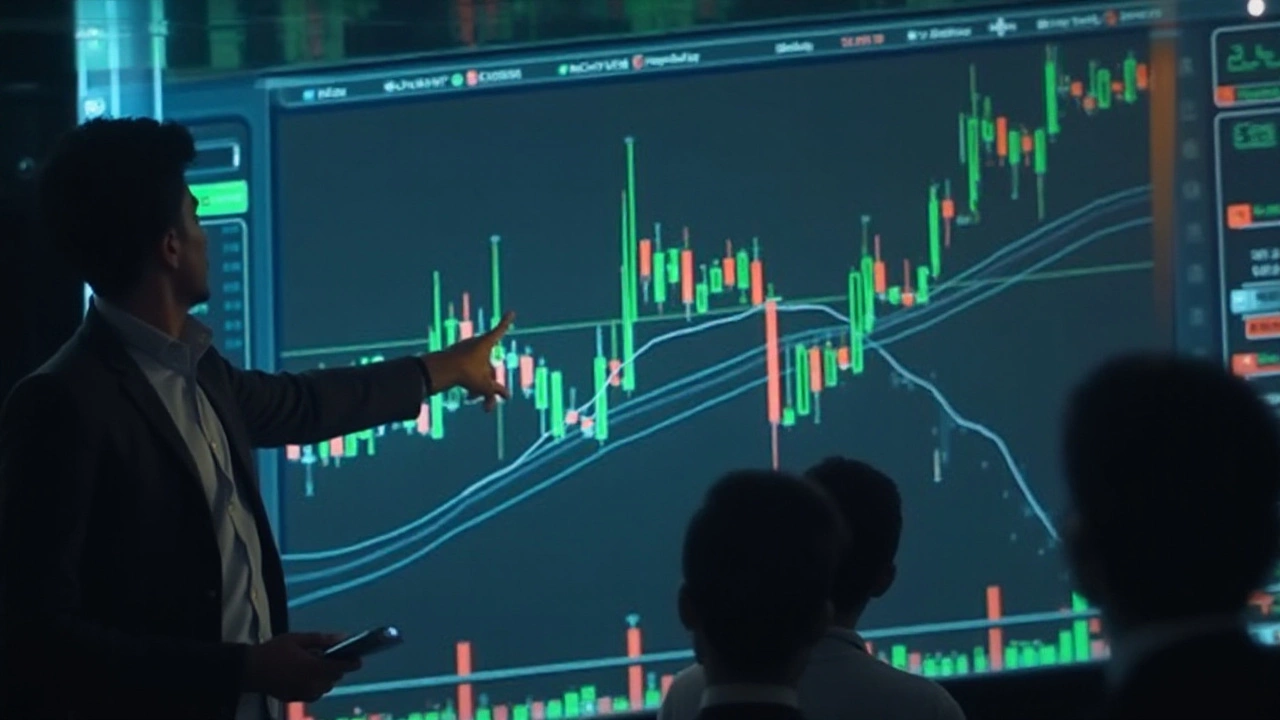
Candlestick charts hold a special place in a trader's toolkit, capturing the ebb and flow of stock prices within a defined timeframe. Among these, the 1-minute candlestick chart is like a short-burst screenplay, documenting each scene of the market's day. This article emerges as a beacon for those overwhelmed by the rapid tempo of modern trading, ready to unfurl the minute-by-minute stories told by these mighty yet tiny candles.
A single day in the stock market offers 1,440 1-minute candles. Each holds vital information about a stock's performance during that precise minute, offering savvy traders just enough room to maneuver and strategize. For seasoned experts and curious newcomers alike, understanding and interpreting these candles can unlock hidden opportunities often missed in the broader strokes of longer timeframes.
This piece aims to guide you through the fundamental aspects of reading these charts. From dissecting the anatomy of a candlestick to employing them in strategic trading, this guide is your partner in making informed decisions. Buckle up and delve deeper into this fascinating world of 1-minute candlesticks to wield them like a seasoned market maestro.
- Understanding Candlestick Charts
- How Many 1-Minute Candles in a Day?
- Decoding the Anatomy of a Candle
- Strategic Uses of 1-Minute Candles
- Tips for Effective Use
- Common Mistakes to Avoid
Understanding Candlestick Charts
Candlestick charts are an invaluable tool in the world of stock market analysis. Born out of ancient Japanese rice trading practices, these charts provide a visual representation of price movements over a specified period of time. At a glance, they reveal the battle between buyers and sellers, showing the open, high, low, and close prices for the given timeframe. This efficiency in storytelling makes them an essential asset for traders looking to navigate the swiftly changing tides of the markets. Not only do they allow investors to quickly assess the psychological market dynamics, but they also offer a glimpse into the probable future movements based on past data. A single glance at a well-constructed candlestick chart can reveal much about the current market sentiment, liquidity, and volatility, making them a critical tool in a trader's arsenal.
Each element of a candlestick chart provides crucial hints about the market's inner workings. The rectangular body represents the price range between the opening and closing prices for the period. If the closing price is higher than the opening price, the body is usually white or green, indicating a bullish market. Conversely, a black or red body signals a bearish market, where the closing price has dipped below the opening. The thin lines, known as 'wicks' or 'shadows', extend above and below the body, signifying the highs and lows of the price during the period. These subtle yet vital details furnish traders with comprehensive insights into the market's behavior.
Incorporating candlestick charts into trading strategies can offer a number of benefits. They allow for trend spotting with patterns like 'doji', 'hammer', and 'engulfing', which correspond with potential market reversals or continuations. Some traders even rely solely on these patterns to guide their trading decisions. According to Steve Nison, a prominent technical analyst credited with popularizing candlestick charts in the West, "What separates winning traders from the rest is that winning traders manage to control their emotions and wait patiently for the right setup." This patient interpretation of candlestick indicators is an art form, honed over time and with practice, making it a critical skill for any trader looking to improve.
The popularity of candlestick charts among traders is bolstered by their effectiveness in different kinds of markets. It doesn't matter if you're trading stocks, commodities, or cryptocurrencies; the principles remain largely the same, providing a flexible toolset that can be applied universally. The adoption of candlestick charts has even prompted analytics platforms to offer advanced pattern recognition algorithms, helping traders spot patterns they might otherwise miss. While technology has undoubtedly expanded their accessibility and ease of use, understanding the foundational aspects of candlestick charts enriches a trader's perspective, transforming data points into actionable insights.
Let's delve into the world of candlestick patterns briefly. Consider the 'hammer', a pattern usually found at the bottom of a downtrend, suggesting a potential reversal where buyers come into control after a period of selling pressure. Another intriguing pattern is the 'shooting star', often a warning of a potential peak and forthcoming price decline. Insightful traders learn not just to recognize these patterns, but to understand the context in which they appear, imbuing their strategies with both art and science.
As we dive deeper into the utilization of candlestick charts for market analysis and strategy development, it's worthwhile to reflect on the abundant data and visual clarity they provide. This advanced visualization of price action can immensely aid in honing one's trading skills. By mastering the concepts inherent in candlestick analysis, including the symbiotic relationship between price trends and timeframes, traders can better predict forthcoming stock movements while simultaneously embracing the associated risks with greater ease.
How Many 1-Minute Candles in a Day?
Picture this: the stock market, a vibrant ecosystem where numbers, emotions, and decisions dance together on financial charts. One of the most dynamic players in this arena is the 1-minute candlestick. If one were to count the candles faithfully documenting the market's every heartbeat in a typical trading day, the total reaches a staggering 1,440 candles. Each of these candles encapsulates a unique story, a microcosm of trading activities, ebbs and flows that reflect investor sentiment, market direction, and the irresistible momentum that keeps traders glued to their screens.
To break it down, these 1-minute candlestick charts operate during the standard trading session which lasts approximately six and a half hours, from 9:30 AM to 4:00 PM EST. The precision of these candles offers invaluable granularity, allowing traders to witness the fluctuations and gain insights which might go unnoticed in longer-term charts. This frequency provides an up-close look at the hyperactive exchanges happening in the bustling electronic universe, making it indispensable for day traders and stock market enthusiasts seeking to make rapid decisions. Here, every minute is a battlefield of buying and selling pressures, shaping the way traders perceive the pulse of the market.
Understanding the full scope of 1,440 1-minute candles requires patience and a keen eye. Each candle tells a story of the minute it represents—open, high, low, and close prices. The candle's body and wicks add layers of information concerning volatility and price movements. This chart, filled with scores of little vertical bars and lines, becomes a powerful storytelling tool for those seeking to delve into the art of trading. With charts plastered with 1-minute candles, traders can spy on patterns such as flags, pennants, or wedges, patterns that offer insight into the market troops' strategies.
"Trading requires one to have the diligence to navigate each minute with precision and a perpetual learning mindset," says Paul Tudor Jones, a renowned stock market magnate.
The intricacies lying within these 1-minute candles can be daunting at first glance. Yet, they are gateways to understanding short-term market movements like no other chart. The ability to dissect the minute by minute triumphs and failures can provide a competitive edge, distinguishing between the novice and the seasoned trader. Appreciating the stories these candles tell is often the first step towards formulating refined short-term strategies. So, the next time you set your sights on a 1-minute chart, remember that each one enshrines a precious nugget of information, waiting to be harvested by a discerning eye for future gains.

Decoding the Anatomy of a Candle
The world of candlestick charts is vast, yet every story they tell begins with understanding the basic anatomy of a candle. A candlestick chart is a simple yet effective visual representation of stock price movements. It captures the open, close, high, and low of a price over a given timeframe, encapsulated within the shape of a candle. Now, let's dissect it step by step. Each candlestick has a body that indicates the opening and closing price levels over a specific time, with a color distinction often indicating whether the closing price was higher or lower than the opening price. A green or white-bodied candle suggests a closing price higher than the opening price, hinting a bullish stance, while a red or black-bodied candle suggests the opposite.
The thin lines extending above and below the candle's body are known as wicks or shadows, representing the highest and lowest price levels reached during that period of trading. For a trader navigating through the volatile currents of the stock market, these shadows can signal the market's sentiment and volatility at precise moments. The length of a candlestick's body in relation to its wicks can be particularly telling. A longer body with short wicks may suggest strong conviction by buyers or sellers, depending on the color of the candle. Conversely, long wicks with short bodies could indicate indecision in the market, where prices fluctuated significantly within the period, but closed close to the open.
Understanding these nuances can be beneficial for both novices and experienced traders. Insights drawn from the candle's structure can illuminate hidden market dynamics and create a sharper understanding of price action. As renowned technical analyst Steve Nison, who popularized candlestick charting, once remarked,
"Candlesticks are flexible. They can be used alone or in combination with other technical tools."This flexibility allows traders to spot potential reversals, confirm trends, and refine entry and exit strategies with precision.
Let's not forget the importance of context when reading candlesticks. Single candles tell a story, but the narrative becomes richer when observed in a sequence or pattern. Recognizing formations like the doji, hammer, or engulfing patterns can add depth to a trader's skill set, drawing a clearer picture of the market's evolving story. In this intricate dance of price movements, every candle becomes a stepping stone towards a more informed decision, weaving a visual tale of market psychology and sentiment.
Strategic Uses of 1-Minute Candles
In the fast-paced realm of stock trading, the 1-minute candles flicker like the heartbeat of the market, revealing the pulse that astute traders sync with. These candles allow traders to hone into the minutiae of price movements and capitalize on short-term opportunities. 1-minute charts are instrumental for day traders who make swift decisions, often entering and exiting positions within mere minutes. The substantial number of 1,440 candles in a single trading day serves as a goldmine for extracting intricate data, turning volatility into an asset rather than a hurdle. Every candlestick, painted on this fast canvas, narrates a story not visible at first glance in longer timeframes like the 5-minute or daily charts.
Day traders rely heavily on these rapid timeframes to perform scalping strategies, aiming for small profits from minimal price changes during short durations. In such a cutthroat environment, precision and timing are critical. By analyzing 1-minute candles, these traders can identify immediate support and resistance levels more accurately. The detailed insights allow for crafting careful strategies, steering clear of the broader strokes that 15-minute or hourly candles adopt. When an asset fluctuates, these early warnings help prepare for impulsive stock movements, saving crucial time in crafting a reaction plan. The fast and furious nature of this approach makes it all the more challenging yet rewarding for those ready to act on their feet.
Another noteworthy tactic with rapid candles involves exploiting the market's opening hours. The first 30 minutes of a trading day, often considered as the most volatile, provide traders with ample opportunity to leverage short timeframes like the 1-minute candle. Specific patterns such as morning stars or engulfing patterns, when appearing in these first moments, can set the tone for trades that follow, bolstered by tight stop-loss placements safeguarding against market whims. While not all traders view volatility as beneficial, adept users of 1-minute candlesticks interpret these rapid ebbs and flows as precursors of larger trends. As Jesse Livermore once said,
"The big money is not in the individual fluctuations but in the main movements."His approach underscores the importance of diving into the smallest of details to anticipate broader market tides.
Moreover, though some dismiss 1-minute charts for being too noisy, many investors find value in pairing them with macro indicators. When trading large volumes or in highly volatile markets, supplementary tools such as volume analysis or moving averages lend more clarity to the fast-moving candlestick stage. They provide confirmation, preventing false signals that may arise purely from price bars. By using complementary methods, traders can pinpoint precise entry and exit points, harnessing not just the candle shapes but their surrounding context within the bustling trading environment. Thus, rather than getting swayed by sudden market shifts, informed decisions evolve from synchronized indicator interpretations, unified with the artful readings of 1-minute market fluctuations.

Tips for Effective Use
The use of 1-minute candles can be a double-edged sword; they offer acute precision but demand meticulous attention. To start with, it's crucial to focus on the broader market context. Before diving into minute-by-minute analysis, understand the larger trend. Is it a bull or bear market? Knowing whether the broader trend supports your trading direction can significantly enhance decision-making. Synchronizing smaller timeframes with larger trends provides a strong backbone for any trading strategy.
When utilizing these candlestick charts, always consider starting with a pre-trading routine. Set up your chart templates carefully; include moving averages that match your strategy cues. Also, incorporate key support and resistance levels; these will act as navigational beacons in your journey. The importance of a properly configured chart layout cannot be overstated, as it ensures your focus remains undivided when the decisive moment arrives.
Another key aspect is to personalize your trading timeframes. Not all traders can afford to keep their eyes glued to the screen throughout a session. Identify peak hours when trading volumes and volatility spike, often coinciding with market open and close. Engaging during these windows can maximize your potential while giving you well-deserved breaks between active periods. After all, strategic pauses can offer fresh perspectives and prevent mental fatigue.
Patience and Timing
Successful trading on a 1-minute chart requires both patience and impeccable timing. Witness the charm of these candlesticks: they offer a continuous cycle of opportunity. However, seize these opportunities with precision. Reacting impulsively to every minor price movement is a common pitfall. Instead, let candlesticks form entire patterns or shapes before drawing conclusions. Observe the high and low wicks—often, they evidence rejection levels where prices might reverse. According to famous market strategist John Bollinger, “Market timing must be precise because stocks can and often do continue in one direction after a breakout.”
Incorporating statistical tools can bolster confidence in your trades. Use stochastics, RSI (Relative Strength Index), or MACD (Moving Average Convergence Divergence) indicators to provide at-a-glance analysis support. These indicators often reveal overbought or oversold conditions, giving valuable clues on when to enter or exit a trade. Tables like the one below highlight average indicator levels:
| Indicator | Oversold Level | Overbought Level |
|---|---|---|
| RSI | 30 | 70 |
| Stochastics | 20 | 80 |
A common mantra among traders is to let profits ride and cut losses short. The rapid nature of 1-minute candles can sometimes amplify this principle. Set predetermined stop-loss and target prices for each trade. Trailing stops can be your ally in securing profits should your predictions prove correct. By employing calculated risk management practices, traders can maintain a cool head even in wildly fluctuating scenarios.
Adapt and Learn Continuously
Trading on such short timeframes is dynamic and requires an adaptable mindset. Learning continuously is crucial. Attend webinars, read books, and join trading communities to share insights and strategies. Staying updated with news is essential, as unexpected geopolitical or economic developments can drastically affect markets. Engage with these resources regularly, and remember to refine your strategy with lessons learned from each trade.
Common Mistakes to Avoid
In the swift world of trading, the allure of the 1-minute candlestick chart can be overwhelming. These quick changing graphs convey a wealth of information, but they also set traps for the unwary trader. Awareness of frequent mistakes is crucial to avoid losses and enhance the effectiveness of using these charts. One common error is over-trading. The rapid shifts seen on 1-minute candles can entice traders into making numerous transactions, often without a well-formed strategy in place. This approach can lead to exorbitant fees and potential financial pitfalls, as it relies on impulse rather than a calculated plan. Strategies should be clear and grounded in analysis despite the allure of fleeting opportunities. Instead of reacting to every blink of the candlestick, taking a broader view can sometimes offer a more stable, informed path.
Another misstep is neglecting to incorporate longer time frames into analysis. While the 1-minute chart provides granular data, it can be misleading on its own. Neglecting to consider longer periods can mask prevailing trends and lead to misinterpretation of data. Traders often benefit from integrating insights from extended periods, creating a comprehensive picture that accounts for both micro and macro-level changes. Acknowledging the broader market context helps avoid myopic views limited by the immediate patterns captured by 1-minute candles.
Ignoring technical indicators holds many traders back from achieving their full potential. RSI (Relative Strength Index), moving averages, and trend lines are valuable tools that can enhance decision-making when used in tandem with candlestick charts. Relying solely on visual chart reading overlooks these valuable indicators, leading to less informed decisions. Expert traders emphasize blending visual observations with technical signals to bolster accuracy. Using these tools ensures a more rounded approach and aligns trades with confirmed patterns rather than impulsive reactions.
"The essence of strategy is choosing what not to do," said Michael Porter, and this philosophy resonates strongly in trading.
Lastly, the psychological component of trading is often underestimated. Emotional trading, driven by fear or greed, can cloud judgment and compromise decision-making, particularly when faced with the fast-moving nature of 1-minute charts. Emotional responses can prompt traders to ignore their strategies, leading to hasty, ill-advised actions. Education in stress management techniques and maintaining discipline, regardless of market fluctuations, helps traders keep a clear head and stick to their game plan. Recognizing the vital role psychology plays in trading success can prevent common mistakes and lead to more effective use of 1-minute candlestick charts in navigating the stock market.





Write a comment